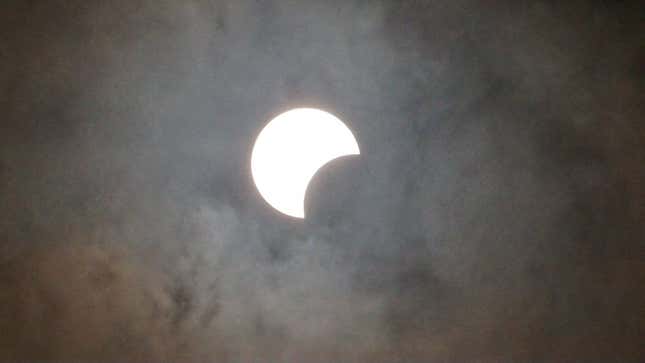this Great North American Solar Eclipse Happened on Monday, but considering Latest weather forecast, many people across the continent looked up and saw nothing but clouds. If so, here’s what you can expect.
During a total eclipse, the moon passes between the Earth and the sun, casting a shadow on the Earth. When gazing at this spectacle through a clear sky, the sun’s auroras, or atmosphere, become visible, the sky darkens to the point where stars can be seen, and the weather becomes noticeably colder. In the minutes before and after totality, strange shadows, called shadow bands, can be seen on flat surfaces.
related: Essential Guide to Getting the Best Solar Eclipse Experience
Needless to say, clouds significantly reduce the aesthetics of this experience, but it’s not a complete offset. As Matthew Cappucci, a meteorologist and atmospheric scientist with the MyRadar app, told me, other aspects can still grab your attention.
“You don’t notice the shadow bands, so you don’t notice anything weird on the ground, and you obviously can’t see the sun or the moon,” he said. “But you have a better chance of seeing the shadow coming because now you have something that can cast it.”
You may see the moon’s shadow sweep across the sky and move across the clouds, Capucci said, which he said looked “very strange” and which he saw firsthand during an eclipse in Chile four years ago. He explained that it became noticeably darker, but there was nothing to observe other than an overall darkening.
The strangest thing, however, is that on an overcast day, the edges of the shadows are still a little brighter; so while you won’t see a full 360-degree sunrise, you’ll find that the horizon appears brighter, Cappucci said. This was especially strange because although it was very dark and cloudy overhead, there were brighter clouds on the horizon. “It looks weird – like you’re in the middle of this ring,” he said.
When it comes to clouds, it’s also important to note their insulating effect on surface temperatures. Cappucci explained that the cloud acts like a thermal blanket, trapping heat that would otherwise be radiated into space during the darkness of the eclipse. Some of the heat is reflected from the clouds back to the ground. As a result, temperatures drop less in places with cloud cover than in clear skies with dry air, where temperatures are more likely to drop sharply.
Other things to watch out for during a cloudy total solar eclipse are sudden changes in the feel of the air and possible changes in wind speed. As it gets slightly darker, you may also notice some changes in animal behavior, such as birds returning to their nests or nocturnal animals becoming more active. Finally, the last thing you’ll notice is that you won’t be using those eclipse glasses anymore.

Now, if the weather is clear and you can see part of the sun, you can still have a real treat. I learned this during last October’s annular solar eclipse, during which time I captured some cool and eerie photos of the spectacle. So don’t be discouraged if the weather is expected to be partly cloudy or sunny.
Whether you can see the sun clearly or it’s obscured by clouds, the upcoming solar eclipse is still an extraordinary event worth experiencing.
To get more spaceflight in your life, follow us X And bookmark it specifically for Gizmodo Aerospace page.